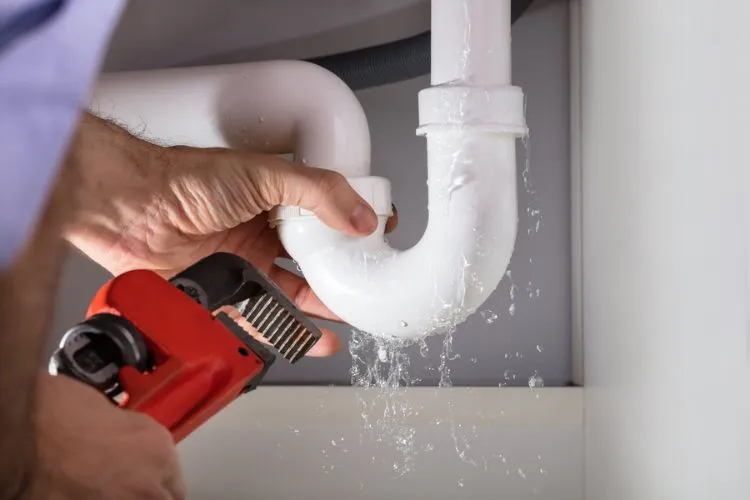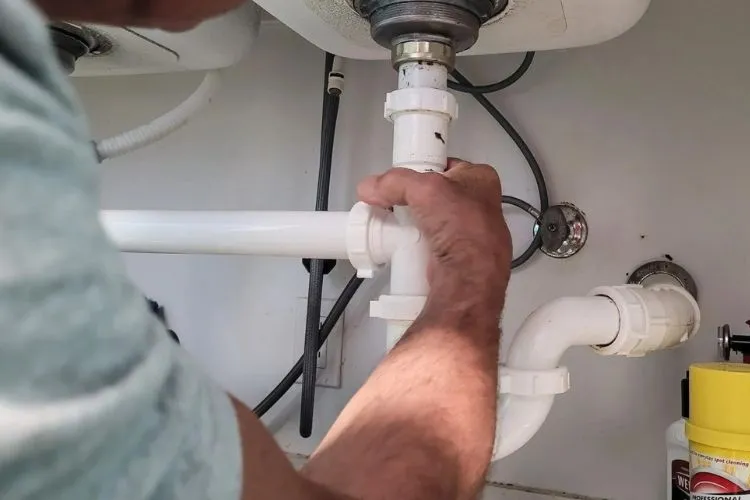Water softeners are crucial in many households, ensuring that hard water is transformed into soft, usable water devoid of harsh minerals.
Nonetheless, owners may sometimes face a baffling issue: a water softener leaking from the drain line.
This article aims to shine a light on why leaks from the drain line occur and how they can be effectively managed.

Understanding Water Softeners
Water softeners work on a simple principle: they remove minerals like calcium and magnesium from water, which are responsible for making it “hard.”
The drain line in a water softener plays a pivotal role, as it facilitates the removal of these minerals once they’re separated from the water. A leak in this component can disrupt the softening process and lead to various issues.
Why Is My Water Softener Leaking From The Drain Line?
Several factors can contribute to a water softener’s drain line leaking, ranging from simple to complex issues.
Clogs and Blockages
One of the primary reasons for leaks is the buildup of mineral deposits or sediment, which can cause clogs. These blockages prevent water from flowing smoothly through the drain line, sometimes resulting in leaks.
The initial sign of a clog is reduced water flow or pressure, indicating that it’s time to inspect the drain line.
Incorrect Drain Line Installation
Improper installation of the drain line can also lead to leaks. If the line isn’t fitted correctly or securely, water may escape, causing damage over time. The key is to ensure that the installation follows the manufacturer’s guidelines closely to avoid any issues.
Worn Out or Loose Fittings
With time, the fittings that keep the drain line in place may wear out or become loose. Regular maintenance is essential to catch and rectify these issues before they cause leaks.
Checking the condition of these fittings periodically can save a lot of trouble.
High Water Pressure
Sometimes, the problem may arise from the water pressure being too high for the drain line to handle, leading to leaks. Checking the water pressure and adjusting it to an appropriate level can mitigate this issue.
Valve Malfunctions
The valves, especially the bypass valve, play a crucial role in a water softener. If they fail to function correctly, leaks can occur. Keeping an eye on these valves and ensuring they’re working well can prevent leakage problems.
Troubleshooting Leaks from the Drain Line

Identifying the source of a leak might seem daunting, but with a step-by-step approach, it becomes manageable.
Step-by-Step Guide to Identifying the Leak Source
Start by visually inspecting the drain line for any obvious signs of damage or wear. Next, check for clogs by looking for mineral buildup or sediment. Finally, examine the fittings and valves for wear and tear or incorrect installation.
Tips on Fixing the Leak
DIY Solutions
For minor issues like clogs or loose fittings, simple DIY solutions can be effective. For example, unclogging the drain line using a cleaner recommended for water softeners or tightening loose fittings might solve the problem.
Always remember to turn off the water supply before attempting any repairs.
When to Call a Professional
If the leak persists despite your efforts, or if the issue seems complex, calling a professional is advisable. Professionals can diagnose and solve problems that might not be obvious to a homeowner.
Preventative Maintenance
Preventing future leaks is as crucial as fixing current ones. Regular checks of the drain line, water pressure, and valves can help identify potential issues before they escalate.
A maintenance schedule can ensure that nothing gets overlooked.
Pro Tips

Using high-quality replacement parts can extend the life of your repairs and prevent future leaks.
Additionally, installing a water softener drain line flow control can be a wise move to manage water flow and pressure, reducing the risk of leaks.
Safety Precautions
When maintaining a water softener, it’s crucial to handle chemicals and equipment with care to prevent accidents and spills. Always wear protective gloves and goggles to shield your skin and eyes from harsh chemicals like salt pellets or potassium chloride used in water softeners.
Ensure the workspace is well-ventilated to avoid inhalation of dust or fumes. Follow the manufacturer’s instructions precisely when adding or replacing chemicals. Store water softener chemicals in a dry, cool place, away from children and pets.
In the event of a spill, clean it up immediately to prevent slipping hazards or chemical damage to the surrounding area. By adhering to these safety measures, you can safely maintain your water softener system and protect your health and home.
Frequently Asked Questions (FAQs)
How often should I inspect my water softener for leaks?
It’s wise to inspect your water softener at least every six months. However, more frequent checks might be necessary depending on your area’s water hardness and the system’s age.
Can a leaking water softener drain line cause significant damage to my property?
Yes. If left unaddressed, leaks can lead to water damage and potentially mold growth, which can be costly to repair.
What should I do if I cannot find the source of the leak?
If the leak’s source remains elusive despite your efforts, it’s time to call a professional plumber who specializes in water softeners.
Is it better to repair a leaking drain line or replace it?
This depends on the leak’s cause. If the issue stems from a simple clog or loose fitting, a repair might suffice. However, for more severe damage, replacement might be necessary.
Can I extend the lifespan of my water softener to prevent future leaks?
Yes, through regular maintenance and timely repairs, you can extend the lifespan of your water softener and minimize the risk of leaks.
Conclusion:
A water softener leaking from the drain line can be a source of frustration. Yet, understanding the common causes and knowing how to tackle them can make handling such issues less daunting.
Remember, the key is to act promptly and seek professional help when necessary.


